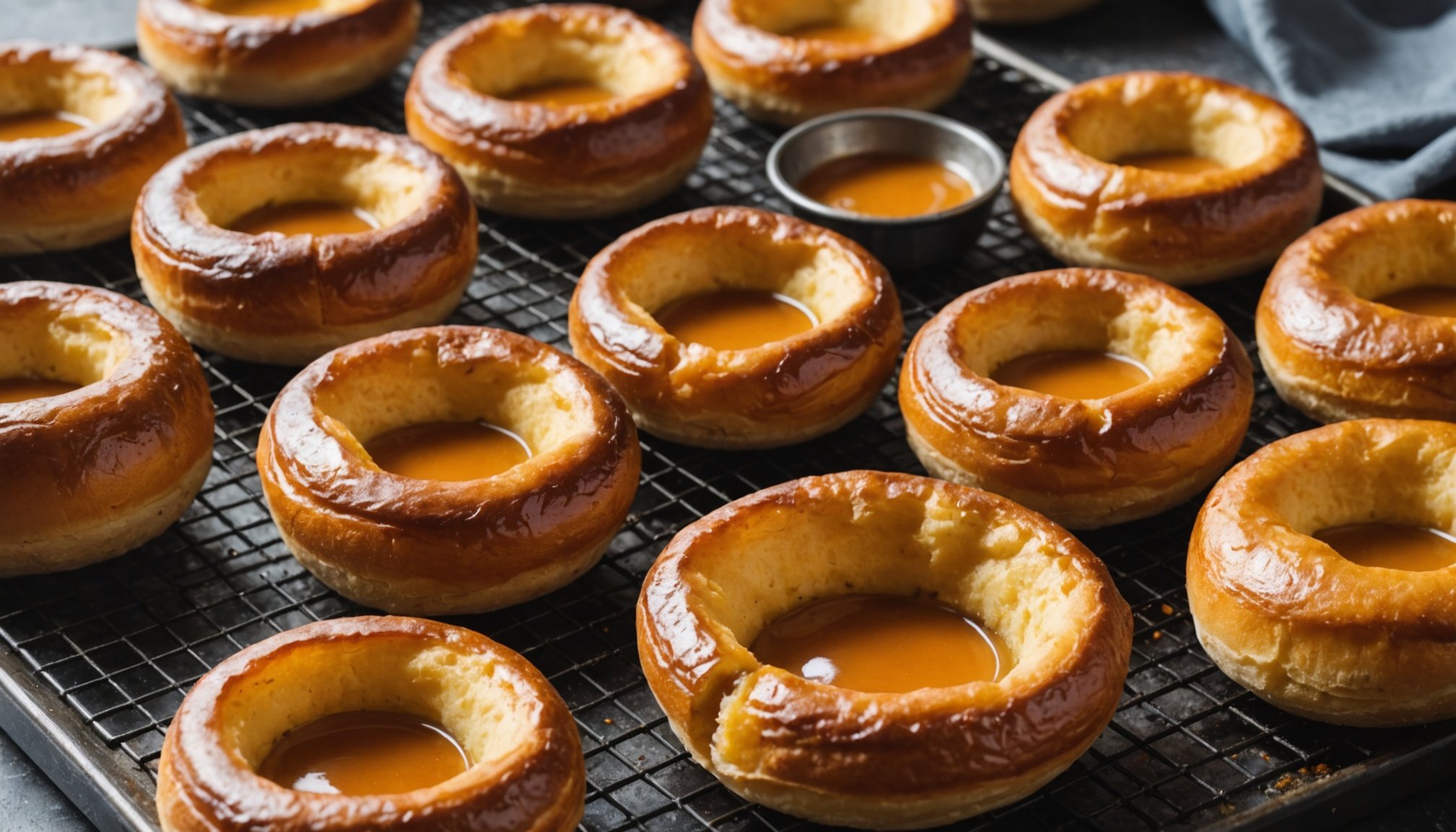Understanding Yorkshire Puddings
The origins of Yorkshire puddings date back to the 18th century in England. Initially called “dripping puddings” due to the practice of catching drippings from roast meats, these puddings were designed to be a starter course to curb appetites before the main meat dish. This practice highlighted the resourcefulness of British cuisine in utilising every part of their meal preparation efficiently.
In British culinary tradition, Yorkshire puddings hold significant cultural value. They are a staple of the famous “Sunday roast” and are often associated with celebrations and family gatherings. Their presence on a dining table is symbolic of comfort and nostalgia, transcending generations with their timeless appeal. As such, mastering this dish is often considered a rite of passage for many home cooks in England.
Also to discover : Unveil the Ultimate Recipe for Irresistibly Indulgent Sticky Toffee Pudding That Will Keep You Coming Back for More!
Traditionally, Yorkshire puddings are served with beef, accompanied by rich gravy. They can also be paired with sausages in a dish known as “toad in the hole.” Despite these conventional practices, the allure of Yorkshire puddings has inspired many chefs to experiment, incorporating varied flavours and contemporary ingredients to expand their culinary versatility.
Essential Ingredients for Fluffy Yorkshire Puddings
When it comes to crafting the perfect Yorkshire puddings, selecting the right ingredients is paramount. Regarding flour, a high-protein content such as strong bread flour is recommended, as it helps the puddings to rise well and maintain their structure. However, if dietary restrictions are a concern, gluten-free flour can be used as an alternative, ensuring everyone can enjoy this classic dish without compromise.
Additional reading : Master the Perfect English Pimm’s Cup: Top Tips and Techniques for an Impeccable Recipe
The role of eggs and milk is also crucial in achieving the desired fluffiness. Eggs contribute to the rich, golden color and provide the lift needed during baking. Whole milk is preferred for its fat content, which adds flavour and texture, creating a beautifully soft interior.
For those exploring alternative options, nut or oat milk can substitute, although they may slightly alter the traditional taste and texture. Embracing these ingredients is key to maintaining the puddings’ essence while accommodating different dietary needs. Understanding the balance between these components will guarantee a delightful culinary experience each time, allowing both traditionalists and modern cooks to savour this beloved dish.
Step-by-Step Guide to Preparing Yorkshire Puddings
Creating the perfect Yorkshire puddings involves careful preparation and attention to detail. Each step in the step-by-step process is crucial for achieving delightful results.
Preparing the Batter
Begin by combining your chosen ingredients: flour, eggs, and milk. Ensure the mixing is thorough to achieve a smooth batter, free of lumps. A good mixing technique involves gradually incorporating the milk while whisking, which helps to aerate the batter and prevent it from becoming too thick. This stage is foundational to achieving the light texture characteristic of an exceptional Yorkshire pudding.
Resting the Batter
Once mixed, allow the batter to rest. Resting is essential for texture, as it lets the ingredients meld and any gluten development to relax. This period improves the batter’s ability to rise impressively once cooked.
Preheating the Oven
Preheating is vital; a hot oven ensures the puddings puff up beautifully. Opt for optimal temperatures, typically around 220°C (428°F). Using a hot oven allows for immediate steam generation, a key factor in achieving the characteristic rise. Additionally, using a pre-heated pan enhances puffiness by creating an immediate cooking reaction.
Techniques for Achieving Fluffiness
Achieving fluffiness in Yorkshire puddings requires understanding the impact of oven temperature on their texture. The proper heat ensures the puddings rise and develop their characteristic airy interior. A high oven temperature, around 220°C (428°F), is crucial. It creates an immediate steam reaction, lifting the batter and forming the desired puffiness. This initial burst of heat is a primary factor for the perfect rise.
Using hot pan drippings is another secret. Before adding batter, coat the pan or muffin tins with hot drippings. This technique not only enhances flavour but also assists in achieving a remarkable texture. The combination of heat and fat results in a crisp exterior and fluffy center.
To avoid common pitfalls, ensure the batter doesn’t have lumps or isn’t overly thick. Overmixing can lead to tough puddings. Finally, be aware of frequent eye-level opening of the oven, as it cools, preventing the necessary heat consistency required to maintain their shape. Applying these carefully curated tips ensures Yorkshire puddings’ optimal fluffiness, allowing both seasoned cooks and newcomers to delight in their preparation.
Utilizing Pan Drippings for Flavor
Pan drippings are essential in boosting the flavour of Yorkshire puddings. They originate from the fats and juices released from roasting meats, carrying a rich and savoury depth essential to traditional recipes. When choosing ideal drippings, consider the meat used; drippings from beef or pork roast deliver robust flavours, while chicken or turkey offers a slightly milder taste.
Incorporating these drippings into the batter is straightforward yet requires precision. Begin by preheating the pan drippings in your baking tins to a high temperature, ensuring they sizzle as the batter makes contact. This process sears the batter’s base, enhancing both taste and texture.
Proper collection and storage of pan drippings ensure they maintain their quality. After roasting, let the drippings cool slightly before removing excess fat and any burned bits. Store the remaining liquid in an airtight container, refrigerating it if not used immediately. This preserves the depth of flavour till needed.
By mastering these techniques, you enrich your Yorkshire puddings with a satisfying complex flavour, using traditional methods honed through generations of culinary practice.
Common Issues and Troubleshooting
While making Yorkshire puddings, encountering issues like flat batter can be frustrating. The key to troubleshooting lies in understanding the causes and solutions for these common problems.
If your puddings are coming out flat, one likely culprit could be incorrect oven temperature. Ensure your oven is preheated to at least 220°C (428°F) for the necessary steam reaction. A lower temperature won’t generate enough heat to allow for the desired rise.
Another frequent issue is batter that doesn’t rise. This may occur due to overmixing, which can lead to tough textures. For optimal consistency, mix just until the ingredients are combined. Also, ensure you’re adding your batter to very hot pan drippings, as the temperature shock is what forms a crisp exterior.
Kitchen conditions, such as humidity, might also affect your outcome. On particularly humid days, consider adjusting the flour quantities slightly to achieve the proper consistency.
By closely examining these factors, and making precise adjustments, you can address the common pitfalls of preparing Yorkshire puddings effectively, ensuring a perfect puff each time.
Variations on Traditional Yorkshire Puddings
Exploring innovative flavours can reinvigorate the classic Yorkshire puddings, offering a fresh twist on tradition. Creative variations engage curious cooks and surprise diners with unexpected delights.
Herb-Infused Yorkshire Puddings
The incorporation of herbs like rosemary or thyme into the batter lends a distinctive flavour profile, infusing the puddings with aromatic warmth. This subtle addition complements the traditional richness, making them an exciting side dish for seasoned meats or vegetarian mains.
Cheese-Stuffed Yorkshire Puddings
For a sumptuous treat, consider cheese-stuffed Yorkshire puddings. Cheddar or stilton can be mixed into the batter or tucked into the centers before baking, resulting in a gooey, indulgent interior. This variation is perfect as a standalone snack or as part of an elaborate dinner spread.
Sweet Yorkshire Puddings
Transform your puddings into a delightful dessert by incorporating sweet elements. Adding ingredients like vanilla or using a cinnamon-sugar blend can create a delectable base for toppings such as fruits, compotes, or cream. This clever adaptation reimagines Yorkshire puddings for those with a sweet tooth, showcasing their versatility beyond savoury meals.
Serving Suggestions and Pairings
Elevating your Yorkshire puddings is about pairing them beautifully with both traditional and modern dishes. The classic choice has always been serving them alongside a Sunday roast, complemented by succulent beef and rich, savoury gravy. These puddings act as the perfect vehicle for soaking up juices, enhancing their inherent charms.
For more creative serving ideas, consider using Yorkshire puddings as a base for appetizers. Fill them with sautéed mushrooms or smoked salmon for an elegant touch at dinner parties. These toppings introduce complementary textures and flavours, transforming the humble pudding into a sophisticated starter.
Incorporating seasonal dishes can also bring Yorkshire puddings into a contemporary context. In spring or summer, pair them with grilled vegetables or a light, lemony chicken dish, balancing richness with freshness. In colder months, hearty stews or casseroles make for ideal companions.
Additionally, for a unique fusion experience, Yorkshire puddings can be a surprising addition to a brunch spread, served with crispy bacon and soft-boiled eggs. This playful approach reimagines them beyond traditional boundaries, making them a versatile and delightful culinary asset.
Visual Aids and Resources
Understanding Yorkshire puddings and creating the perfect dish can significantly benefit from well-crafted visual aids. Step-by-step imagery is crucial as it provides clarity in preparation techniques, ensuring every detail is captured accurately for aspiring cooks. Images of each stage, from preparing the batter to achieving the perfect rise, can guide even the most inexperienced cook to success.
For learners preferring interactive learning, video tutorials offer dynamic guidance. These tutorials demonstrate the rhythm and cadence of mixing, resting, and baking, helping to visualize the transformation of ingredients into iconic fluffy puddings. Videos that highlight potential points of error and provide corrective measures can be especially useful.
In addition to visual media, exploring a variety of resources can deepen understanding. Books, websites, and cooking classes specialising in British cuisine offer diverse insights into the art and science behind Yorkshire puddings. Digital platforms often provide downloadable guides and printable recipes for hands-on practice. Engaging with these materials not only unveils traditional knowledge but also introduces modern interpretations, fostering culinary creativity and a comprehensive understanding of this cultural staple.











